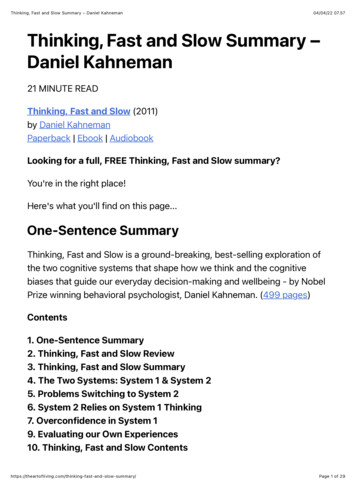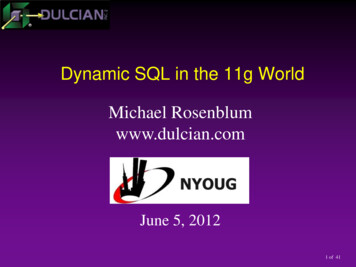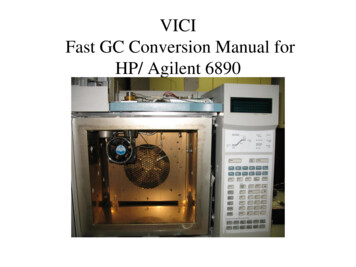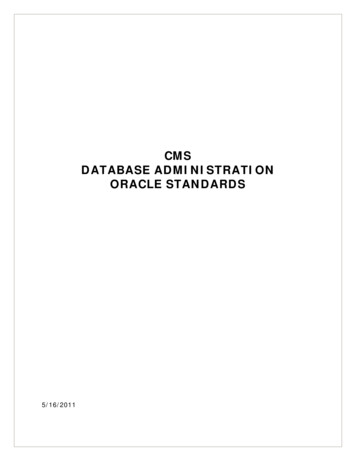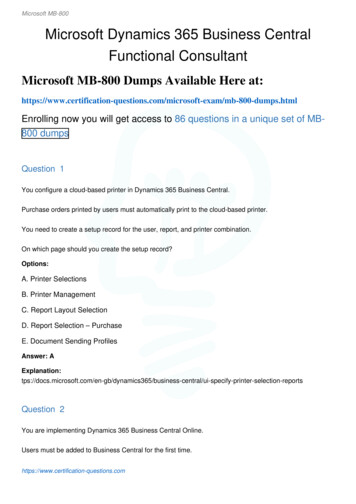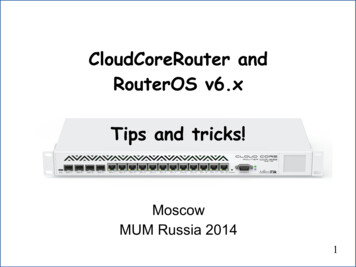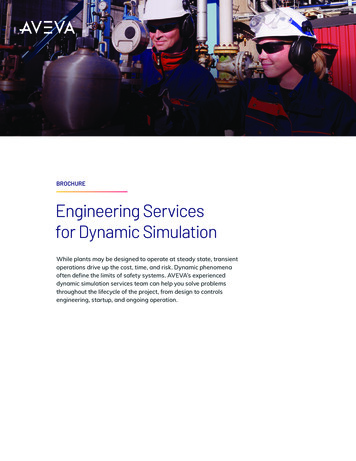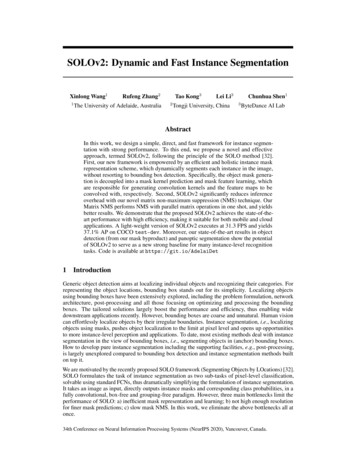
Transcription
SOLOv2: Dynamic and Fast Instance SegmentationXinlong Wang11Rufeng Zhang2The University of Adelaide, AustraliaTao Kong32Lei Li3Tongji University, ChinaChunhua Shen13ByteDance AI LabAbstractIn this work, we design a simple, direct, and fast framework for instance segmentation with strong performance. To this end, we propose a novel and effectiveapproach, termed SOLOv2, following the principle of the SOLO method [32].First, our new framework is empowered by an efficient and holistic instance maskrepresentation scheme, which dynamically segments each instance in the image,without resorting to bounding box detection. Specifically, the object mask generation is decoupled into a mask kernel prediction and mask feature learning, whichare responsible for generating convolution kernels and the feature maps to beconvolved with, respectively. Second, SOLOv2 significantly reduces inferenceoverhead with our novel matrix non-maximum suppression (NMS) technique. OurMatrix NMS performs NMS with parallel matrix operations in one shot, and yieldsbetter results. We demonstrate that the proposed SOLOv2 achieves the state-of-theart performance with high efficiency, making it suitable for both mobile and cloudapplications. A light-weight version of SOLOv2 executes at 31.3 FPS and yields37.1% AP on COCO test-dev. Moreover, our state-of-the-art results in objectdetection (from our mask byproduct) and panoptic segmentation show the potentialof SOLOv2 to serve as a new strong baseline for many instance-level recognitiontasks. Code is available at https://git.io/AdelaiDet1IntroductionGeneric object detection aims at localizing individual objects and recognizing their categories. Forrepresenting the object locations, bounding box stands out for its simplicity. Localizing objectsusing bounding boxes have been extensively explored, including the problem formulation, networkarchitecture, post-processing and all those focusing on optimizing and processing the boundingboxes. The tailored solutions largely boost the performance and efficiency, thus enabling widedownstream applications recently. However, bounding boxes are coarse and unnatural. Human visioncan effortlessly localize objects by their irregular boundaries. Instance segmentation, i.e., localizingobjects using masks, pushes object localization to the limit at pixel level and opens up opportunitiesto more instance-level perception and applications. To date, most existing methods deal with instancesegmentation in the view of bounding boxes, i.e., segmenting objects in (anchor) bounding boxes.How to develop pure instance segmentation including the supporting facilities, e.g., post-processing,is largely unexplored compared to bounding box detection and instance segmentation methods builton top it.We are motivated by the recently proposed SOLO framework (Segmenting Objects by LOcations) [32].SOLO formulates the task of instance segmentation as two sub-tasks of pixel-level classification,solvable using standard FCNs, thus dramatically simplifying the formulation of instance segmentation.It takes an image as input, directly outputs instance masks and corresponding class probabilities, in afully convolutional, box-free and grouping-free paradigm. However, three main bottlenecks limit theperformance of SOLO: a) inefficient mask representation and learning; b) not high enough resolutionfor finer mask predictions; c) slow mask NMS. In this work, we eliminate the above bottlenecks all atonce.34th Conference on Neural Information Processing Systems (NeurIPS 2020), Vancouver, Canada.
Mask R-CNNMask R-CNNCOCO Mask AP4035SOLOv2SOLOMask 2502550100Inference time (ms)125SOLOv2Ours150(a)AccuracySpeed vs. Accuracy(a)vs. Speed(b) Detail Comparison(b) SegmentationDetail ComparisonFigure 1 – Comparison of instance segmentation performance by SOLOv2 and other methods on the COCOtest-dev. (a) The proposed SOLOv2 outperforms a range of state-of-the-art algorithms. All methods areevaluated using one Tesla V100 GPU. (b) SOLOv2 obtains higher-quality masks compared with Mask R-CNN.Mask R-CNN’s mask head is typically restricted to 28 28 resolution, leading to inferior prediction at objectboundaries.We first introduce a dynamic scheme, which enables dynamically segmenting objects by locations.Specifically, the mask learning process can be divided into two parts: convolution kernel learning andfeature learning (Figure 2(b)). When classifying the pixels into different location categories, the maskkernels are predicted dynamically by the network and conditioned on the input. We further constructa unified and high-resolution mask feature representation for instance-aware segmentation. As such,we are able to predict high-resolution object masks, as well as learning the mask kernels and maskfeatures separately and efficiently.We further propose an efficient and effective matrix NMS algorithm. As a post-processing step forsuppressing the duplicate predictions, non-maximum suppression (NMS) serves as an integral part instate-of-the-art object detection systems. Take the widely adopted multi-class NMS for example. Foreach class, the predictions are sorted in descending order by confidence. Then for each prediction, itremoves all other highly overlapped predictions. Such sequential and recursive operations result innon-negligible latency. For mask NMS, this drawback is further magnified. Compared to boundingbox, it consumes more time to compute the IoU of each mask pair, thus leading to huge overhead.We address this problem by introducing Matrix NMS, which performs NMS with parallel matrixoperations in one shot. Our Matrix NMS outperforms the existing NMS and its varieties in bothaccuracy and speed. As a result, Matrix NMS processes 500 masks in less than 1 ms in simple pythonimplementation, and outperforms the recently proposed Fast NMS [2] by 0.4% AP.With these improvements, SOLOv2 outperforms SOLO by 1.9% AP while being 33% faster. TheRes-50-FPN SOLOv2 achieves 38.8% mask AP at 18 FPS on the challenging MS COCO dataset,evaluated on a single V100 GPU card. A light-weight version of SOLOv2 executes at 31.3 FPS andyields 37.1% mask AP. Interestingly, although the concept of bounding box is thoroughly eliminatedin our method, our bounding box byproduct, i.e., by directly converting the predicted mask to itsbounding box, yields 44.9% AP for object detection, which even surpasses many state-of-the-art,highly-engineered object detection methods.We believe that, with our simple, fast and sufficiently strong solution, instance segmentation can bea popular alternative to the widely used object bounding box detection, and SOLOv2 may play animportant role and predict its wide applications.1.1Related WorkInstance segmentation. Instance segmentation is a challenging task, as it requires instance-leveland pixel-level predictions simultaneously. The existing approaches can be summarized into threecategories. Top-down methods [20, 12, 25, 14, 6, 2, 4, 38] solve the problem from the perspectiveof object detection, i.e., detecting first and then segmenting the object in the box. In particular,recent methods of [4, 38, 35] build their methods on the anchor-free object detectors [31], showingpromising performance. Bottom-up methods [27, 9, 24, 10] view the task as a label-then-cluster2
problem, e.g., learning the per-pixel embeddings and then clustering them into groups. The latestdirect method (SOLO) [32] aims at dealing with instance segmentation directly, without dependenceon box detection or embedding learning. In this work, we appreciate the basic concept of SOLO andfurther explore the direct instance segmentation solutions.We specifically compare our method with the recent YOLACT [2]. YOLACT learns a groupof coefficients which are normalized to ( 1, 1) for each anchor box. During the inference, itfirst performs a bounding box detection and then uses the predicted boxes to crop the assembledmasks. While our method is evolved from SOLO [32] through directly decoupling the original maskprediction into kernel learning and feature learning. No anchor box is needed. No normalizationis needed. No bounding box detection is needed. We directly map the input image to the desiredobject classes and object masks. Both the training and inference are much simpler. As a result, ourproposed framework is much simpler, yet achieving significantly better performance (6% AP betterat a comparable speed); and our best model achieves 41.7% AP vs. YOLACT’s best 31.2% AP.Dynamic convolutions. In traditional convolution layers, the learned convolution kernels stay fixedand are independent on the input, i.e., the weights are the same for arbitrary image and any locationof the image. Some previous works explore the idea of bringing more flexibility into the traditionalconvolutions. Spatial Transform Networks [16] predicts a global parametric transformation to warpthe feature map, allowing the network to adaptively transform feature maps conditioned on the input.Dynamic filter [17] is proposed to actively predict the parameters of the convolution filters. It appliesdynamically generated filters to an image in a sample-specific way. Deformable ConvolutionalNetworks [8] dynamically learn the sampling locations by predicting the offsets for each imagelocation. Pixel-adaptive convolution [29] multiplies the weights of the filters and a spatially varyingkernel to make the standard convolution content-adaptive. Yang et al. [37] apply conditional batchnormalization to video object segmentation and AdaptIS [28] predicts the affine parameters, whichscale and shift the features conditioned on each instance. They both belong to the more generalscale-and-shift operation, which can roughly be seen as an attention mechanism on intermediatefeature maps. We bring the dynamic scheme into instance segmentation and enable learning instancesegmenters by locations. Note that the concurrent work in [30] also applies dynamic convolutions forinstance segmentation by extending the framework of BlendMask [4]. The dynamic scheme part issomewhat similar, but the methodology is different. CondInst [30] relies on the relative position todistinguish instances as in AdaptIS, while SOLOv2 uses absolute positions as in SOLO. It means thatit needs to encode the position information N times for N instances, while SOLOv2 performs it allat once using the global coordinates, regardless how many instances there are.Non-maximum suppression. NMS is widely adopted in many computer vision tasks and becomesan essential component of object detection and instance segmentation systems. Some recent works [1,26, 13, 3, 2] are proposed to improve the traditional NMS. They can be divided into two groups,either for improving the accuracy or speeding up. Instead of applying the hard removal to duplicatepredictions according to a threshold, Soft-NMS [1] decreases the confidence scores of neighborsaccording to their overlap with higher scored predictions. Adaptive NMS [26] applies dynamicsuppression threshold to each instance, which is tailored for pedestrian detection in a crowd. In [13],the authors use KL-Divergence and reflected it in the refinement of coordinates in the NMS process.To accelerate the inference, Fast NMS [2] enables deciding the predictions to be kept or discarded inparallel. Note that it speeds up at the cost of performance deterioration. Different from the previousmethods, our Matrix NMS addresses the issues of hard removal and sequential operations at the sametime. As a result, the proposed Matrix NMS is able to process 500 masks in less than 1 ms in simplepython implementation, which is negligible compared with the time of network evaluation, and yields0.4% AP better than Fast NMS.2Proposed Method: SOLOv2An instance segmentation system should separate different instances at pixel level. To distinguishinstances, we follow the basic concept of ‘segmenting objects by locations’ [32]. The input image isconceptually divided into S S grids. If the center of an object falls into a grid cell, then the grid cellcorresponds to a binary mask for that object. As such, the system outputs S 2 masks in total, denoted2as M RH W S . The k th channel is responsible for segmenting instance at position (i, j), wherek i · S j (see Figure 2(a)).3
FCN,M: H W I(a) SOLOG: S S DkernelbranchFCNI( ,( ,))featurebranch*F: H W E(b) SOLOv2Figure 2 – SOLOv2 compared to SOLO. I is the input feature after FCN-backbone representation extraction.Dashed arrows denote convolutions. k i · S j; and ‘ ’ denotes the dynamic convolution operation.Such paradigm could generate the instance segmentation results in an elegant way. However, thereare three main bottlenecks that limit its performance: a) inefficient mask representation and learning.It takes a lot of memory and computation to predict the output tensor M , which has S 2 channels.Besides, as the S is different for different FPN level, the last layer of each level is learned separatelyand not shared, which results in an inefficient training. b) inaccurate mask predictions. Finerpredictions require high-resolution masks to deal with the details at object boundaries. But largeresolutions will considerably increase the computational cost. c) slow mask NMS. Compared withbox NMS, mask NMS takes more time and leads to a larger overhead.In this section, we show that these challenges can be effectively solved by our proposed dynamicmask representation and Matrix NMS, and we introduce them in the sequel.2.1Dynamic Instance SegmentationWe first revisit the mask generation in SOLO [32]. To generate the instance mask of S 2 channelscorresponding to S S grids, the last layer takes one level of pyramid features F RH W E asinput and at last applies a convolution layer with S 2 output channels. The operation can be written as:Mi,j Gi,j F,1 1 Ewhere Gi,j Ris the convolution kernel, and Mi,j Ronly one instance whose center is at location (i, j).(1)H Wis the final mask containingIn other words, we need two input F and G to generate the final mask M . Previous work explicitlyoutput the whole M for training and inference. Note that tensor M is very large, and to directlypredict M is memory and computational inefficient. In most cases the objects are located sparselyin the image. M is redundant as only a small part of S 2 kernels actually functions during a singleinference.From another perspective, if we separately learn F and G, the final M could be directly generatedusing the both components. In this way, we can simply pick the valid ones from predicted S 2 kernelsand perform the convolution dynamically. The number of model parameters also decreases. Whatis more, as the predicted kernel is generated dynamically conditioned on the input, it benefits fromthe flexibility and adaptive nature. Additionally, each of S 2 kernels is conditioned on the location.4
It is in accordance with the core idea of segmenting objects by locations and goes a step further bypredicting the segmenters by locations.2.1.1Mask Kernel GGiven the backbone and FPN, we predict the mask kernel G at each pyramid level. We first resizethe input feature FI RHI WI C into shape of S S C. Then 4 convs and a final 3 3 Dconv are employed to generate the kernel G. We add the spatial functionality to FI by giving the firstconvolution access to the normalized coordinates following CoordConv [23], i.e., concatenating twoadditional input channels which contains pixel coordinates normalized to [ 1, 1]. Weights for thehead are shared across different feature map levels.For each grid, the kernel branch predicts the D-dimensional output to indicate predicted convolutionkernel weights, where D is the number of parameters. For generating the weights of a 1 1 convolutionwith E input channels, D equals E. As for 3 3 convolution, D equals 9E. These generated weightsare conditioned on the locations, i.e., the grid cells. If we divide the input image into S S grids, theoutput space will be S S D, There is no activation function on the output.2.1.2Mask Feature FSince the mask feature and mask kernel are decoupled and separately predicted, there are two waysto construct the mask feature. We can put it into the head, along with the kernel branch. It means thatwe predict the mask features for each FPN level. Or, to predict a unified mask feature representationfor all FPN levels. We have compared the two implementations in Section 3.1.2 by experiments.Finally, we employ the latter one for its effectiveness and efficiency.For learning a unified and high-resolution mask feature representation, we apply feature pyramidfusion inspired by the semantic segmentation in [18]. After repeated stages of 3 3 conv, groupnorm [34], ReLU and 2 bilinear upsampling, the FPN features P2 to P5 are merged into a singleoutput at 1/4 scale. The last layer after the element-wise summation consists of 1 1 convolution,group norm and ReLU. More details can be referred to supplementary material. It should be noted thatwe feed normalized pixel coordinates to the deepest FPN level (at 1/32 scale), before the convolutionsand bilinear upsamplings. The provided accurate position information is important for enablingposition sensitivity and predicting instance-aware features.2.1.3Forming Instance MaskFor each grid cell at (i, j), we first obtain the mask kernel Gi,j,: RD . Then Gi,j,: is convolved withF to get the instance mask. In total, there will be at most S 2 masks for each prediction level. Finally,we use the proposed Matrix NMS to get the final instance segmentation results.2.1.4Learning and InferenceThe training loss function is defined as follows:L Lcate λLmask ,(2)where Lcate is the conventional Focal Loss [21] for semantic category classification, Lmask is theDice Loss for mask prediction. For more details, we refer readers to [32].During the inference, we forward input image through the backbone network and FPN, and obtain thecategory score pi,j at grid (i, j). We first use a confidence threshold of 0.1 to filter out predictionswith low confidence. The corresponding predicted mask kernels are then used to perform convolutionon the mask feature. After the sigmoid operation, we use a threshold of 0.5 to convert predicted softmasks to binary masks. The last step is the Matrix NMS.2.2Matrix NMSMotivation. Our Matrix NMS is motivated by Soft-NMS [1]. Soft-NMS decays the other detectionscores as a monotonic decreasing function f (iou) of their overlaps. By decaying the scores accordingto IoUs recursively, higher IoU detections will be eliminated with a minimum score threshold.However, such process is sequential like traditional Greedy NMS and could not be implemented inparallel.5
Table 1 – Instance segmentation mask AP (%) on COCO test-dev. All entries are single-model results.Mask R-CNN is our improved version with scale augmentation and longer training time (6 ). ‘DCN’ meansdeformable convolutions used.box-based:Mask R-CNN [12]Mask R-CNN MaskLab [5]TensorMask [6]YOLACT [2]MEInst [38]CenterMask [33]BlendMask [4]box-free:PolarMask [35]SOLO 57.461.6Matrix NMS views this process from another perspective by considering how a predicted mask mjbeing suppressed. For mj , its decay factor is affected by: (a) The penalty of each prediction mi on mj(si sj ), where si and sj are the confidence scores; and (b) the probability of mi being suppressed.For (a), the penalty of each prediction mi on mj could be easily computed by f (ioui,j ). For (b),the probability of mi being suppressed is not so elegant to be computed. However, the probabilityusually has positive correlation with the IoUs. So here we directly approximate the probability by themost overlapped prediction on mi asf (iou·,i ) min f (iouk,i ). sk si(3)To this end, the final decay factor becomesdecayj min si sjf (ioui,j ),f (iou·,i )(4)and the updated score is computed by sj sj · decayj . We consider two most simple decremented iou2functions, denoted as linear f (ioui,j ) 1 ioui,j , and Gaussian f (ioui,j ) exp σi,j .Implementation. All the operations in Matrix NMS could be implemented in one shot withoutrecurrence. We first compute a N N pairwise IoU matrix for the top N predictions sorteddescending by score. For binary masks, the IoU matrix could be efficiently implemented by matrixoperations. Then we get the most overlapping IoUs by column-wise max on the IoU matrix. Next, thedecay factors of all higher scoring predictions are computed, and the decay factor for each predictionis selected as the most effect one by column-wise min (Eqn. (4)). Finally, the scores are updated bythe decay factors. For usage, we just need thresholding and selecting top-k scoring masks as the finalpredictions.The pseudo-code of Matrix NMS is provided in supplementary material. In our code base, MatrixNMS is 9 faster than traditional NMS and being more accurate (Table 3(c)). We show that MatrixNMS serves as a superior alternative of traditional NMS in both accuracy and speed, and can beeasily integrated into the state-of-the-art detection/segmentation systems.3ExperimentsTo evaluate the proposed method SOLOv2, we conduct experiments on three basic tasks, instancesegmentation, object detection, and panoptic segmentation on MS COCO [22]. We also presentexperimental results on the recently proposed LVIS dataset [11], which has more than 1K categoriesand thus is considerably more challenging.6
Table 2 – Instance segmentation results on the LVISv0.5 validation dataset. means re-implementation.Mask-RCNN [11]Mask-RCNN -3 5.838.244.947.024.424.625.526.8Table 3 – Ablation experiments for SOLOv2. All models are trainedval2017 unless noted.(a) Kernel shape. The perfor- (b) Explicit coordinates. Precisemance is stable when the shape coordinates input can considerablygoes beyond 1 1 256.improve the results.Kernel shapeAPAP50AP753 3 641 1 641 1 1281 1 2561 1 140.240.440.4(d) Mask feature representation.We compare the separate mask feature representation in parallel headsand the unified representation.Kernel Feature3333on MS COCO train2017, test on(c) Matrix NMS. Matrix NMS outperforms other methods in bothspeed and 8.058.538.638.539.440.4Hard-NMSSoft-NMSFast NMSMatrix NMS(e) Training schedule. 1 means12 epochs using single-scale training. 3 means 36 epochs withmulti-scale training.Iter?Time(ms)AP3377922 1 136.336.536.236.6(f) Real-time SOLOv2. The speedis reported on a single V100 GPUby averaging 5 runs (on COCOtest-dev).Mask fpsSeparateUnified37.337.858.258.540.040.41 3 .154.057.736.139.746.531.33.1Instance SegmentationFor instance segmentation, we report lesion and sensitivity studies by evaluating on the COCO 5Kval2017 split. We also report COCO mask AP on the test-dev split, which is evaluated on theevaluation server. SOLOv2 is trained with stochastic gradient descent (SGD). We use synchronizedSGD over 8 GPUs with a total of 16 images per mini-batch. Unless otherwise specified, all modelsare trained for 36 epochs (i.e., 3 ) with an initial learning rate of 0.01, which is then divided by 10 at27th and again at 33th epoch. We use scale jitter where the shorter image side is randomly sampledfrom 640 to 800 pixels.3.1.1Main ResultsWe compare SOLOv2 to the state-of-the-art methods in instance segmentation on MS COCO testdev in Table 1. SOLOv2 with ResNet-101 achieves a mask AP of 39.7%, which is much better thanother state-of-the-art instance segmentation methods. Our method shows its superiority especially onlarge objects (e.g., 5.0 APL than Mask R-CNN).We also provide the speed-accuracy trade-off on COCO to compare with some dominant instancesegmenters (Figure 1 (a)). We show our models with ResNet-50, ResNet-101, ResNet-DCN-101 andtwo light-weight versions described in Section 3.1.2. The proposed SOLOv2 outperforms a rangeof state-of-the-art algorithms, both in accuracy and speed. The running time is tested on our localmachine, with a single V100 GPU. We download code and pre-trained models to test inference timefor each model on the same machine. Further, as described in Figure 1 (b), SOLOv2 predicts muchfiner masks than Mask R-CNN which performs on the local region.Beside the MS COCO dataset, we also demonstrate the effectiveness of SOLOv2 on LVIS dataset.Table 2 reports the performances on the rare (1 10 images), common (11 100), and frequent ( 100)subsets, as well as the overall AP. Both the reported Mask R-CNN and SOLOv2 use data resamplingtraining strategy, following [11]. Our SOLOv2 outperforms the baseline method by about 1% AP.For large-size objects (APL ), our SOLOv2 achieves 6.7% AP improvement, which is consistent withthe results on the COCO dataset.7
3.1.2Ablation ExperimentsWe investigate and compare the following five aspects in our methods.Kernel shape. We consider the kernel shape from two aspects: number of input channels and kernelsize. The comparisons are shown in Table 3(a). 1 1 conv shows equivalent performance to 3 3conv. Changing the number of input channels from 128 to 256 attains 0.4% AP gains. When it growsbeyond 256, the performance becomes stable. In this work, we set the number of input channels to be256 in all other experiments.Effectiveness of coordinates. Since our method segments objects by locations, or specifically, learnsthe object segmenters by locations, the position information is very important. For example, if themask kernel branch is unaware of the positions, the objects with the same appearance may have thesame predicted kernel, leading to the same output mask. On the other hand, if the mask feature branchis unaware of the position information, it would not know how to assign the pixels to different featurechannels in the order that matches the mask kernel. As shown in Table 3(b), the model achieves36.3% AP without explicit coordinates input. The results are reasonably good because that CNNs canimplicitly learn the absolute position information from the commonly used zero-padding operation,as revealed in [15]. The pyramid zero-paddings in our mask feature branch should have contributedconsiderably. However, the implicitly learned position information is coarse and inaccurate. Whenmaking the convolution access to its own input coordinates through concatenating extra coordinatechannels, our method enjoys 1.5% absolute AP gains.Unified mask feature representation. For mask feature learning, we have two options: to learnthe feature in the head separately for each FPN level or to construct a unified representation. Forthe former one, we implement as SOLO and use seven 3 3 convolutions to predict the maskfeatures. For the latter one, we fuse the FPN’s features in a simple way and obtain the unified maskrepresentations. The detailed implementation is in supplementary material. We compare these twomodes in Table 3(d). As shown, the unified representation achieves better results, especially for themedium and large objects. This is easy to understand: In separate way, the large-size objects areassigned to high-level feature maps of low spatial resolutions, leading to coarse boundary prediction.Matrix NMS. Our Matrix NMS can be implemented totally in parallel. Table 3(c) presents thespeed and accuracy comparison of Hard-NMS, Soft-NMS, Fast NMS and our Matrix NMS. Sinceall methods need to compute the IoU matrix, we pre-compute the IoU matrix in advance for faircomparison. The speed reported here is that of the NMS process alone, excluding computing IoUmatrices. Hard-NMS and Soft-NMS are widely used in current object detection and segmentationmodels. Unfortunately, both methods are recursive and spend much time budget (e.g., 22 ms). OurMatrix NMS only needs 1 ms and is almost cost free! Here we also show the performance of FastNMS, which utilizes matrix operations but with performance penalty. To conclude, our Matrix NMSshows its advantages on both speed and accuracy.Real-time setting. We design two light-weight models for different purposes. 1) Speed priority,the number of convolution layers in the prediction head is reduced to two and the input shorter side is448. 2) Accuracy priority, the number of convolution layers in the prediction head is reduced tothree and the input shorter side is 512. Moreover, deformable convolution [8] is used in the backboneand the last layer of prediction head. We train both models with the 3 schedule, with shorter siderandomly sampled from [352, 512]. Results are shown in Table 3(f). SOLOv2 can not only pushstate-of-the-art, but has also been ready for real-time applications.3.2Extensions: Object Detection and Panoptic SegmentationAlthough our instance segmentation solution removes the dependence of bounding box prediction,we are able to produce the 4-D object bounding box from each instance mask. The best model ofours achieve 44.9% AP on COCO test-dev. SOLOv2 beats most recent methods in both accuracyand speed, as shown in Figure 3. Here we emphasize that our results are directly generated from theoff-the-shelf instance mask, without any box based supervised training or engineerin
methods, our Matrix NMS addresses the issues of hard removal and sequential operations at the same time. As a result, the proposed Matrix NMS is able to process 500 masks in less than 1 ms in simple python implementation, which is negligible compared with the time of network evaluation, and yields 0.4% AP better than Fast NMS. 2 Proposed Method .

